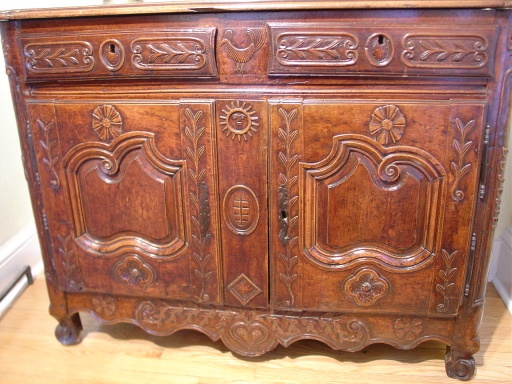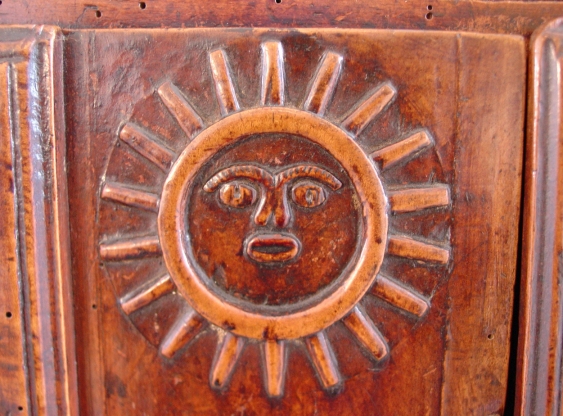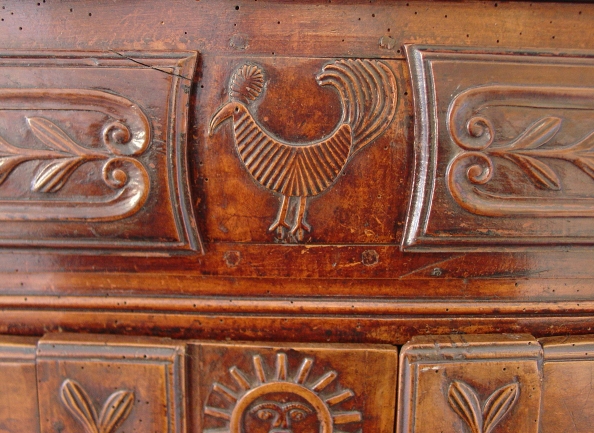|
|
|
|
|
Item #FB-0021French Louis XV Buffet from Brittany
|
|
|
Description: FOR EXHIBITION ONLY - From the Proprietor's personal collection, a circa 1730 to 1745 French Louis XV Buffet from Brittany, France. Two drawers above two doors, and showing extensive carvings in relief. Note the minimal use of hardware, so as not to detract from the carved design. Made of cherry and pine and resting on carved escargot feet. Each carving has a symbolic meaning, and when all put together, tell a story.
|

|
|
|
|
|
|
|
In approximately 1730 to 1745, Monsieur Dufestel (his name is carved in relief on the right hand side edge) commissioned this piece to be made in the Brittany region of France. As there was no middle class in Europe at this time, Mr. Dufestel had to have been a man of some means in order to be able to afford such an item. The reddish cherry cola color of this buffet is classic and typical for pieces being made in the Brittany region during the time period.
|

|
|
|
|
Also in carved relief (on the left hand side edge) is the Fleur Di Lis and beneath that, a caricature of Mr. Dufestel himself. The Fleur Di Lis, national symbol of France, is also the symbol of light and hope. It is sometimes associated with the trinity, and has also been a sign of royalty.
|

|
|
|
|
|
Figuring prominently is a carved sun with a face. The sun represents strength and being all-powerful and life-giving. The drawers and doors have carved raised laurel leaves, which since the ancient Greeks have been associated with strength, vitality, and victory.
|

|
|
|
|
The leaves on the door edges have a spiraled base, suggestive of the Tree of Life, a popular and important design motif.
|

|
|
|
Many Celtic people had crossed the English channel and settled in Brittany, and local culture was inevitably influenced.
The Celtic crosses carved into the bottom of each door represent good luck, as do the carved knots in each center. The apron bears a carved turnip with greens coming out of the top, a classic Brittany decorative motif. It has a dual meaning, and is meant to be a heart shape as well. In this example we can see that the heart is cleaved and there is a star on each side, indicating two loves. Perhaps his children, or parents, or first wife who died and subsequent remarriage?
|

|
|
|
|
|
The meaning of the 4 flower carvings, one at the top of each door and at each end of the apron is unknown at this time. Also unknown are the two carvings beneath the sun and above the apron, on the center of the piece. (If you know, could you please let us know at stillwellhouse@aol.com, thank you!) It is unique and unusual that the two drawers have curved ends, but curves are typically associated with the Louis XV style
|

|
|
|
|
|
|
|
|
|
|
|
Perhaps most interesting of all is the carved peacock between the drawers. Peacocks as a decorative symbol have seven tail feathers and are a symbol of beauty, dignity, and pride. Because it was once believed that their flesh would not rot after death, they are also a symbol of immortality. Ironically, here we are almost 300 years later, and yet we are still thinking about the life and loves of Monsieur Dufestel.
|

|
|
|
|
|
|
|
|

